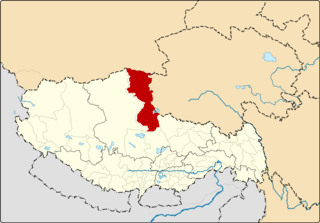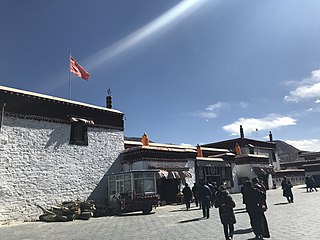This page is based on this
Wikipedia article Text is available under the
CC BY-SA 4.0 license; additional terms may apply.
Images, videos and audio are available under their respective licenses.

Sankhuwasabha District is one of 14 districts of Kirat of eastern Nepal. The district's area is 3,480 km² with a population of 159,203 in 2001 and 158,742 in 2011. The administrative center is Khandbari.

Bayingolin Mongol Autonomous Prefecture, often abbreviated to Bayingol, is an autonomous prefecture of the People's Republic of China, bordering Gansu to the east, Qinghai to the southeast, and the Tibet Autonomous Region to the south. It is the largest prefecture-level division nationally, with an area of 462,700 km2 (178,600 sq mi), even larger than its neighbouring province of Gansu. The prefectural capital is Korla.

Yangbajain is a town approximately 87 kilometers (54 mi) north-west of Lhasa, halfway to Damxung in the Tibet Autonomous Region of China. The town lies just south of the Nyainqêntanglha Mountains, in an upland lush green valley surrounded by the tents of nomads with grazing yak and sheep populating the hillside. It is the site Yangpachen Monastery, which was historically the seat of the Shamarpas of Karma Kagyü and the Yangbajing International Cosmic Ray Observatory.

Shuanghu County, also transliterated from Tibetan as Co'nyi County, is a county under the jurisdiction of the prefecture-level city of Nagqu, in the northernmost part of the Tibet Autonomous Region, People's Republic of China. It was formed in 2012, combining the territory of the former Shuanghu Special District with the eastern half of Nyima County. Much of the county is within the Changtang area.

Tradruk Temple in the Yarlung Valley is the earliest great geomantic temple after the Jokhang and some sources say it predates that temple.
Bünsum, Gyaimain is a village in Qonggyai County, Tibet Autonomous Region of China. It lies at an altitude of 4,755 metres.

Burang, known as Purang in Tibetan, is the administrative center of Burang County, Ngari Prefecture of in the Tibet Autonomous Region (TAR) (China). The town lies at 4,755 metres altitude in the valley of the Sarayu Karnali River. To the south are Gurla Mandhata and the Abi Gamin ranges. Lake Manasarovar and Mount Kailash are to the north. This region is the mythological and actual river nexus of the Himalaya with sources of the Indus, Ganges and Yarlung Tsangpo/Brahmaputra all within 110 kilometres (70 mi) of Burang.
Chacang is a township in Xainza County, Tibet Autonomous Region of China.
Chamco is a village and township (村) in Tingri County, Tibet Autonomous Region of China. It lies at an altitude of 4,255 metres.

Risum is a village in the Tibet Autonomous Region of China. It is located in Rutog County in the Ngari Prefecture and is near the border with Kashmir.
Pazhug is a village in the Tibet Autonomous Region of China.

Garco is a village in the Tibet Autonomous Region of China.

Goin'gyibug is a village and township in the Tibet Autonomous Region of China.
Gyamco Township is a township of Tingri, Tibet Autonomous Region. Its downtown area, Guore village, also referred as Gyaco in English, is a village in the Tibet Autonomous Region of China.
Tomra is a village in the Tibet Autonomous Region of China.
Kaika is a village in the Tibet Autonomous Region of China.
Lêba is a village and township in the Tibet Autonomous Region of China.
Mükangsar is a village in the Tibet Autonomous Region of China.
Mes Ag Tshoms, birth name Tridé Tsuktsen was the emperor of the Tibetan Empire and the son of Tridu Songtsen and his queen, Tsenma Toktokteng, Princess of Chim. He is usually known by his nickname Mé Aktsom "Bearded Grandfather", which was given to him later in life because he was so hirsute.










